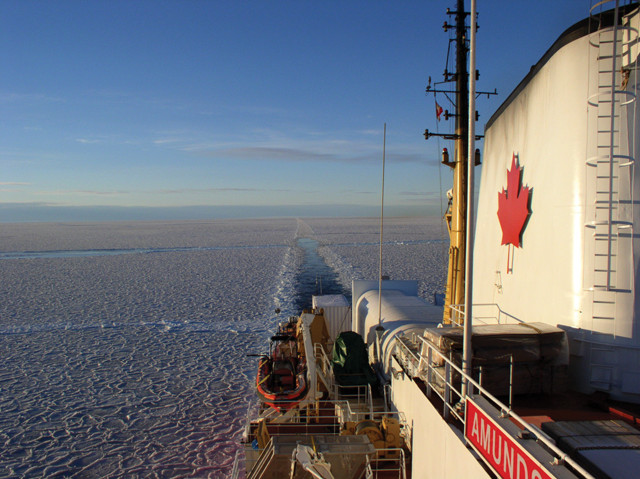
by Sarah Derouin Tuesday, June 5, 2018

The icebreaker CCGS Amundsen breaks a path through the Arctic in October 2010. Credit: Canadian Coast Guard, CC BY-ND 2.0.
From Antarctica to the Arctic; from polar caps, permafrost and glaciers to ocean-rafted sea ice; and from burly bears to cold-loving microbes, fascinating science is found in every nook and crevasse of Earth’s cryosphere, and new findings are announced often. Here are a few of the latest updates.
Warming global temperatures have produced an unexpected transit hazard in the Arctic: Increased amounts of sea ice are on the move. In 2017, an anomalous amount of sea ice along the eastern Canadian coast hemmed in the research icebreaker Amundsen near the east coast of Newfoundland. During the delay in the vessel’s research mission, scientists aboard used the time to make observations and measurements of the large influx of ice. The team’s findings, published in Geophysical Research Letters, showed that areas where ice arches normally form every winter — effectively damming sea ice — are faltering under warmer temperatures. “[More ice mobility] is counterintuitive to most people because it means you can have an increase in local ice hazards because of a changing climate in the high Arctic,” said David Barber of the University of Manitoba in Winnipeg, in a statement. The transient sea ice phenomenon may last at least a couple more decades, he adds, causing hazards for shipping, ferries and fishing.
Subglacial lakes sit in isolated darkness below the Antarctic and Greenland ice sheets, yet scientists have shown that these cold bodies of water can host microbial life. Using echo-radar sounding, a group of researchers has discovered the first subglacial lakes in Canada, lying in a bedrock trough under the Devon Ice Cap on Devon Island west of Baffin Bay. The results of the work, reported in Science, indicate that the base of the ice cap is likely colder than minus 10.5 degrees Celsius, and that the lakes are composed of hypersaline water. These isolated environments may show a unique habitat for microbial evolution. “If there is microbial life in these lakes, it has likely been under the ice for at least 120,000 years, so it likely evolved in isolation,” said Anja Rutishauser of the University of Alberta in a statement. The team suggested their findings could be useful during upcoming space missions to places like icy Europa.
A new study in Limnology and Oceanography Letters looks at how thawing tundra can release carbon trapped in the soil, and how it can affect surface waters. Over 15 years, scientists from Canada and Europe took samples during the summer months from 253 ponds in 14 different Arctic regions. Chemical, biological and optical analyses of the samples revealed a correlation between the extent of permafrost thaw in an area and the amount of dissolved organic carbon in nearby waters, including terrestrial carbon from land sources. The work is the first to examine the effect of rising temperatures on subarctic ponds. “The browning [from increased terrestrial organics] of these systems leads to oxygen depletion and cooler water at the bottom of the ponds, which can have a major impact on the microbial activity responsible for the production and consumption of greenhouse gases, particularly the production of methane, a powerful greenhouse gas,” the authors said in a statement.
© 2008-2021. All rights reserved. Any copying, redistribution or retransmission of any of the contents of this service without the expressed written permission of the American Geosciences Institute is expressly prohibited. Click here for all copyright requests.